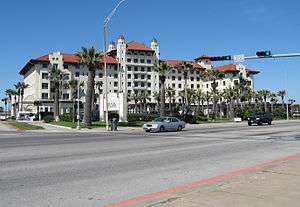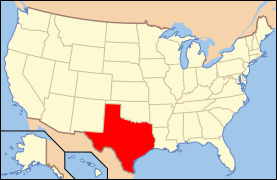Hotel Galvez
The Hotel Galvez is a historic hotel located in Galveston, Texas, United States that opened in 1911. The building was named the Galvez, honoring Bernardo de Gálvez, 1st Viscount of Galveston, for whom the city was named. The building was added to the National Register of Historic Places on April 4, 1979.
Galvez Hotel | |
 Galvez Hotel in 2006 | |
 Galvez Hotel  Galvez Hotel | |
| Location | 2024 Seawall Blvd., Galveston, Texas |
|---|---|
| Coordinates | 29°17′32″N 94°47′8″W |
| Area | 3 acres (1.2 ha) |
| Built | 1910; 109 Years Ago |
| Architect | Mauran & Russell |
| Architectural style | Mission/Spanish Revival |
| NRHP reference No. | 79002944[1] |
| RTHL No. | 7494 |
| Significant dates | |
| Added to NRHP | April 4, 1979 |
| Designated RTHL | 1980 |
Hotel Galvez & Spa, A Wyndham Worldwide grand Hotel is a member of Historic Hotels of America, the official program of the National Trust for Historic Preservation.
History

Galveston civic leaders planned on building the Galvez Hotel in 1898 after a fire destroyed another large hotel (the Beach Hotel) on Galveston Island. After the Hurricane of 1900, the plans accelerated in order to draw tourists back to the island. The hotel was designed by Mauran, Russell & Crowell of St. Louis, Missouri using a combination of Mission Revival and Spanish Revival styles. The hotel opened in June 1911 at a cost of $1 million.
On October 3, 1940, the Galvez Hotel was acquired by William Lewis Moody, Jr. During World War II, the hotel was occupied by the United States Coast Guard for two years and rooms were not rented to tourists. The Galvez's importance to the local economy was restored after the war, particularly during the late 1940s and early 1950s when gambling was popular in Galveston. However, when the illegal gambling industry was shut down in the mid 1950s by the Texas Rangers, the local economy became depressed and the Galvez deteriorated.[2]
The hotel received a major refurbishing in 1965. In 1971, the hotel was acquired by Harvey O. McCarthey and Dr. Leon Bromberg. In 1979, another major renovation to the hotel was initiated by Denton Cooley, who purchased the hotel in 1978, and it became a Marriott franchise in 1989. The hotel was purchased in April 1995 by Galveston native and real estate developer George P. Mitchell. Mitchell restored the hotel to its historic 1911 look. While owned by Mitchell Historic Properties, a 1996 management agreement gave day-to-day operational control to Wyndham Hotels & Resorts under the name Hotel Galvez. The hotel has 226 rooms and suites.
During Hurricane Ike in 2008, the hotel lost clay tiles from its roof and was flooded on its lower level, where the spa, health club, business offices, and laundry were located.[3] The hotel was built in 1911, eleven years after the devastating hurricane that killed approximately 6,000 Galveston Island residents and leveled most of the buildings on the island. The hotel occupies the site where the Beach Hotel, Electric Pavilion, and Pagoda Bathhouse once stood.
The Galvez was referred to as "The Playground of the Southwest" mostly for wealthy socialites, businessmen, and celebrities. American Presidents Franklin D. Roosevelt, Dwight D. Eisenhower, and Lyndon B. Johnson stayed at the Galvez, as did General Douglas MacArthur. Other notable names include Jimmy Stewart, Frank Sinatra, and Howard Hughes. Many of the 6th and 7th floor Junior and Senior suites are named for these famous and infamous personalities.
Gallery
 Hotel Galvez, Galveston, Texas (postcard, circa 1911-1924
Hotel Galvez, Galveston, Texas (postcard, circa 1911-1924 Galveston Electric Co. tracks adjacent to Hotel Galvez (in background) after the 1915 Galveston Hurricane
Galveston Electric Co. tracks adjacent to Hotel Galvez (in background) after the 1915 Galveston Hurricane Galveston Electric Co. tracks through City Park adjacent to Hotel Galvez after the 1915 Galveston Hurricane
Galveston Electric Co. tracks through City Park adjacent to Hotel Galvez after the 1915 Galveston Hurricane
See also
References
- "National Register Information System". National Register of Historic Places. National Park Service. November 2, 2013.
- "Galvez Hotel" Texas Historic Sites Atlas. Retrieved Dec 27, 2008.
- Wirstiuk, Laryssa. "Hotel Galvez Reopens After Hurricane Ike". Preservation Magazine. Retrieved Dec 27, 2008.
External links
![]()

